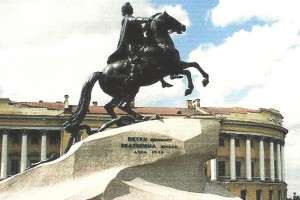Pinky Kase writes about Peter the Great Equestrian Statue
Can you imagine what it must have been like to be 6 feet 8 inches tall, head of the Romanov dynasty and czar of all the Russias? Peter the Great, so named by himself, was able during his reign to war with all of his neighbors, command his courtiers to shave their beards, install French rather than Russian as the language of his court, and move the entire capital of Russia to St. Petersburg, a veritable swamp. In the 300 years since his death he has been the cause of huge debate and discussion. It is known that he was loud-mouthed, violent, ruthless and impetuous. He personally interrogated his own son Alexei, whom he suspected of plotting against him and who confessed after suffering terrible torture. Peter was a giant both physically and mentally.
Can you imagine what it must have been like to be a German princess married to a weak childlike grandson of Peter and then succeed to rule Russia despite having no legal claim to the throne? Surely, many dissidents in this monarchy resented this interloper in the Romanov dynasty. Catherine the Great gained her position through a palace coup, but her control of this empire depended on her being accepted by the dynasty and the Duma. She was anxious to appear as Peter’s rightful heir to gain legitimacy. How better than to honor Peter by erecting a magnificent sculpture in his honor? Thus she solidified her control of Russia with the equestrian sculpture of Peter the Great. Would it not be most gratifying if she too could become a beloved figure in Russia and be honored as Catherine the Great for her contribution to the nation?
Catherine ordered the construction of a monument honoring Peter and had it inscribed with the phrase “Petro Primo, Catharina Secunda” in both Latin and Russian as an expression of Catherine’s attitude toward her predecessor and her view of her own place in the line of great Russian rulers. The work took 12 years to come to fruition. In the fading light of August 7, 1782, all of St. Petersburg turned out to witness the historic unveiling of Russia’s first public monument, the magnificent equestrian portrait of Peter the Great. Since that time, it has stood in Decembrists’ Square on the marshy banks of the Neva River at the frozen northern edge of the city as a symbol of his immense domain. It depicts Peter as the prescient founder of the city, although it also suggests his ruthless campaign to force backward leaning Muscovy into a relationship with the West.
Diderot, the French intellectual greatly admired by Catherine, suggested the sculptor Etienne Falconet for the commission. Falconet arrived in Russia in 1766, caring little for portraiture and never having cast a statue of any size in bronze. Realizing this might well be his last chance at artistic immortality, he undertook the project in 1775, supervised by the fondeur Emelyan Khailov. At one point during the casting the mould broke, pouring molten bronze everywhere and creating fires throughout the foundry. All the workers ran except Khailov who risked his life to salvage the casting. The czar’s face is the work of Marie-Anne Collot, then only 18 years old. She was the stepdaughter of Falconet and served as apprentice on his trip to Russia. She used Peter’s death mask as the basis of her work.
The statue itself stands 20 feet high, but is set on a pedestal 25 feet tall, bringing the total height to some 45 feet. Falconet wanted to work on the stone in its original location, but Catherine ordered it moved before being cut. Embedded half its depth in marshy terrain, new methods had to be devised. Bronze spheres were placed in tracks so that the stone could be rolled. It took 400 men nine months to move the 1500-ton stone to an enormous barge that floated the stone to the Senate Square. This effort alone took nearly 2 years, and when it arrived at the square Catherine had a medal struck commemorating its arrival. Falconet had some of the rock cut away to give the base its current wave-like shape, but it is still the largest sculptured base in history. Perhaps a dubious honor, were it not for the fact that it put Peter the Great in a commanding position over both sea and land. It was conceived not as a pedestal to elevate the bronze, but as an integral part of the whole.
The monolith’s gradual ascent and abruptly lunging profile provided a striking stage for the sculpture and an apt metaphor for Peter’s monarchy. It symbolized the uncharted waters that Peter confronted and conquered in the naval and mercantile empires he built, and the untamed bedrock of old Russia from which his westward looking reign and royal city had sprung. Falconet had never sculpted a horse but he did know his art history; since antiquity the equestrian motif had been associated with the image of a ruler. His explosive rearing charger with its wild expressionistic face gave his rider the perfect image, controlling with calm imperious strength the Russia that he created and the Russia of the future. Clothed in timeless heroic garb he demands the respect of all nations, all peoples and all times. With his arm extended, his palm open, and his head slightly inclined, Peter seems to be a protective, benevolent ruler of his people. His gaze is directed past the Neva River and the golden spire of his Admiralty to a distant westward horizon where he sees a glorious future in which Russia joins its neighbors to the west as an equal. This heroic portrait of Catherine’s predecessor demonstrated her allegiance to his cause and pleaded her own legitimacy. It has survived the Napoleonic invasion, the devastating floods of 1824, and the 900 day German blockade of World War II. It may be a haunting moral lesson in the wages of imperial hubris, but it’s a lot of bang for Catherine’s buck!



Leave a Reply